The War of Attrition
The War of Attrition (Hebrew: מלחמת ההתשה, 'Milhemet HaHatasha') was a war between Israel, Egypt, Jordan and Syria. The war officially started on July 1967, and ended in August 1970. However, the entire period from the end of the Six-Day War in 1967 to the beginning of the Yom Kippur War in 1973 was disturbed by numerous clashes between Israel and its neighbors on the northern, southern, and eastern fronts. The "War of Attrition," therefore, refers to the period between 1967 and 1973 and not only the battles between Israel and Egypt in 1967 - 1970.
1. Background
2. June 1967 - February 1969
3. March 1969 - August 1970
4. Post- War August 1970 - the Yom Kippur War 1973
5. Exchange of Prisoners
1. Background
![]()
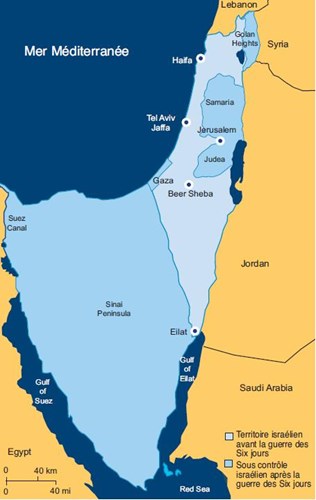
Boundaries of Israel after the Six-Day War
At the end of the Six-Day War, a new reality emerged: the ceasefire lines had completely altered the layout of Israel's map. Its land borders were shortened by 650 km while its maritime borders were extended by 1000 km. The new borders were far from the center of Israel, and forced the IDF to prepare accordingly. In addition, the newly conquered territories were home to an Arab population of nearly one million inhabitants.
The period between the Six-Day War and the Yom Kippur War can be divided into three sub-periods:
- June 1967 - February 1969: Relative calm with Egypt, and strong activity in the regions of Jordan and Judea and Samaria.
- March 1969 - August 1970: The battles of the War of Attrition against Egypt.
- Post-War August 1970 - the Yom Kippur War in 1973: Increased activity in the region of the Golan Heights and Lebanon.
2. June 1967 - February 1969
Sporadic incidents on the Egyptian front and vote of the Khartoum Resolution
At the end of the Six-Day War, an armored brigade held the line of the Suez Canal, and at the end of 1968, a division headquarters was created to direct the forces present on the canal lines and the Sinai. Two armored brigades were subordinate to it, the first being installed along the cease-fire lines and the second in the interior. The Command of the "Solomon Region", responsible for the region of South Sinai, was created.
In September 1967, at the end of the Arab League Summit held in Khartoum, Sudan, the participating Arab states proclaimed the "Three ‘No’s" of the Khartoum Resolution: no peace with Israel, no recognition of Israel, no negotiations with Israel. The first attacks took place as early as July 1967 in the area of the Suez Canal and resulted in the construction of a system of improvised fortifications. In October 1967, the Z-class destroyer INS Eilat was sunk by Egypt, and the IDF retaliated by bombing the refineries of Suez, an action that restored relative calm in the canal area.
![]()

Egyptian complex hit by Israeli artillery fire - 1968
In September 1968, the Egyptians bombarded the line of the zone of the channel of Suez by surprise, and repeated these bombardments in October. During these two incidents, many Israeli soldiers were wounded, and it turned out that the improvised fortifications were not resistant to the bombings. The IDF responded with a raid on Nag Hammadi (Operation Shock) in the heart of Egyptian territory, where bridges and power stations were sabotaged by the Israeli attack force. This raid led to a calm period that lasted about three months, during which the IDF began the construction of a fortified line, the Bar Lev line, named after Haim Bar Lev the IDF Chief Of the General Staff at the time. The Bar Lev line is a series of military posts along the coast, capable of resisting intensive bombardments, with land slopes along the canal and tank stations.
Tense situation on the eastern front
In the Jordan Valley region, military posts were built along the Jordan River, a security fence was built, and means were developed to prevent infiltration into Israeli territory. A line of military posts was also built in the Golan Heights, and a headquarters was established to direct the area.
After the Six-Day War, terrorist organizations tried to import the "People's Liberation War" into the conquered territories of Judea and Samaria. At first, the terrorists enjoyed the complicity of the people, who provided shelter and food. Israel undertook a policy to separate terrorists from the population. Israeli security forces were ruthless towards the terrorists and their accomplices, while striving to maintain contacts with Jordan. The attempt to spark a "war of liberation" failed, but the terrorists succeeded in carrying out a number of attacks in the territories of Judea and Samaria, the Gaza Strip, and Israel.
After their failure, terrorist organizations displaced the center of their activities against Israel in Jordan, and erected their bases on the other side of the ceasefire line. These activities included infiltration, mine-laying, and firing at Israelis across the border. During this period, hundreds of incidents of fire were reported. While most of the incidents were initiated by terrorists, some attempts included the assistance of the Jordanian Army. The Iraqi Army stationed in Jordan, also participated in the events. During the incidents, communities in the Beit Shean valley were severely damaged. The terrorist activity provoked strong IDF responses, culminating in the March 1968 raid on a terrorist camp in the Dead Sea region. This was the most extensive operation since the Six-Day War. The Jordanian Army also took part in the fight alongside the terrorists. This operation made it clear to the terrorist organizations that they would be moved as far as the eastern side of the Jordan Valley. The Jordanians were forced to move their bases eastward on the slopes of the mountains and later, to the top of the mountains.

![]()
Israeli raid on the small town of Karameh in Jordan
Terrorists began to establish themselves in urban concentrations in Jordan in what they referred to as a "state in a state." This led to friction between the terrorists and the Jordanian authorities, which intensified. The IDF reacted to the establishment of these bases by bombings carried out by the Air Force.
In order to avoid the infiltration of terrorist cells, ambushes were organized to trap terrorists directly in Jordan. In response to the cells which succeeded in infiltrating Israel in spite of everything, a new form of combat was developed: the pursuit race. Mobile infantry forces and helicopter-assisted reconnaissance units, assisted by armored tanks, participated in these operations to prevent terrorists from reaching populated areas. The eastern side of the Jordan Valley gradually became a no man's land abandoned by the civilian population.
Following their failures in Israeli territory, the terrorist organizations took a new direction and decided to move to international activities. In December 1968, after three attacks on the Israeli aircraft company El Al outside of Israel, IDF forces raided the Beirut airport and struck Arab airline planes.
3. March 8, 1969 - August 7, 1970
Official start of the war with Egypt
On March 8, 1969, Egyptian President Gamal Abdel Nasser declared the end of the ceasefire with Israel and, simultaneously, the official beginning of the War of Attrition. Egyptian operations included heavy bombardment of Israeli forts and their access roads, air raids, and ambushes in Israeli territory. There were dozens of wounded among the ranks of the IDF. Israeli forces stationed along the channel line retaliated and the Egyptian localities of the area were abandoned and became ghost towns. In order to compel the Egyptians to maintain the ceasefire, the IDF undertook offensive operations, such as raids on the front and in Egyptian territory. But the Egyptian fire did not stop.
![]()

North boundary of the Suez Canal in 1969
The escalation in the fighting began on July 20, 1969. The night before, the Israeli Navy special forces, Shayetet 13, and Sayeret Matkal raided the Green Island in the northern Gulf of Suez, and the next day the Air Force began attacking the Egyptian forces on the Suez Canal line without interruption. The IDF continued its air operations in the heart of the Egyptian territory and made an incursion into the west coast of the Gulf of Suez with armored tanks at the beginning of September 1969. The Egyptians suffered great losses, and in December 1969, most of the Egyptian anti-aircraft missile batteries had been destroyed. As a result, the number of Israeli casualties decreased as they progressed along the canal line.
On January 7 1970, the War of Attrition took a turn when the Israeli Air Force began bombing military targets in the heart of Egyptian territory. Military bases and missile batteries were destroyed in the Nile Delta and Cairo regions. In February 1970, the Soviets assumed responsibility for Egypt's anti-aircraft defense, deploying missile batteries and combat aircrafts.

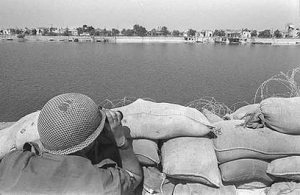
Israeli soldier observing Egyptian positions with binoculars
In April 1970, the Egyptians intensified the fighting by artillery fire, tank shelling, air attacks, ambushes and raids on fortified places in Israeli territory. In mid-April, the Israeli Air Force ceased bombing in Egyptian territory, but continued to attack targets along the Suez Canal line. By the end of May, the Egyptians executed two ambushes in Israeli territory, which left many Israelis wounded and led to a surge in fighting. The Israeli Air Force retaliated by attacking the northern area of the canal, striking the Egyptian infrastructure and cutting off the land connections leading to Port Said. Later, an attack was launched on the Egyptian line in this area. The Egyptian forces were hit hard, but succeeded in advancing missile batteries towards the line. The Israeli Air Force attacked and destroyed some of these batteries, but suffered losses. In June 1970, the Americans initiated discussions to obtain a ceasefire, which came into force on August 7.
Lull on the Jordanian front
In the Jordanian region, security efforts were made to counteract attempts to infiltrate Israel. Terrorists attacked by military posts, artillery, and rockets at the settlements of the Beit Shean Valley and the Jordan Valley as well as the Dead Sea region and Arabah. The IDF prepared to put an end to this terrorist activity by executing ambushes, Dead Sea Marine patrols and raids on the east side of the line.
In February 1970, the first crisis between the terrorists and the Jordanian Army took place. In April 1970, King Hussein of Jordan was forced to surrender to the terrorists and establish the government they wanted. However, the incidents between the Jordanian Army and the terrorists resumed, and resulted in a violent confrontation in September 1970 known as "Black September".
Opening of a front in the north with Syria and Lebanon
The Syrian border, which was relatively calm since the end of the Six Day War, was now the scene of an escalation of violence.
Each month, 40 incidents took place on average at this border. The Syrian Army increased the number of bombings of observation posts, air attacks on Israeli military posts, and ambushes. It authorized the expansion of the activities of the terrorist organizations in Syria, and they ambushed, attacked vehicles and laid mines. The IDF retaliated and even took the initiative to launch "combat days", which included artillery and tank fire, Air Force attacks and helicopter raids in the heart of Syrian territory. The culmination of these offensive operations during this period were reached during three days of combat, during which a considerable number of Syrian soldiers were wounded or killed.
In 1968, terrorist organizations began to establish bases on the southwestern slopes of Mount Hermon. The terrorists came from the area, dubbed the "Fatah Land", to carry out terrorist attacks in Israel. Nearly 80 attacks were committed in 1969, and 200 in 1970. The terrorists tried to operate west of the Hasbani river, but they came up against the resistance of the Lebanese authorities. However, in November 1969, the "Cairo Agreements" were signed between Lebanon and the terrorists, authorizing the launch of operations from that area. The activities of the terrorists included rocket attacks to the communities in northern Israel, the strafing of vehicles on the northern route, and infiltrations for the purpose of carrying out attacks. A serious attack took place in May 1970, when a school bus was attacked by a terrorist on a road in northern Israel. Twelve children were killed and 29 people were injured during the attack.
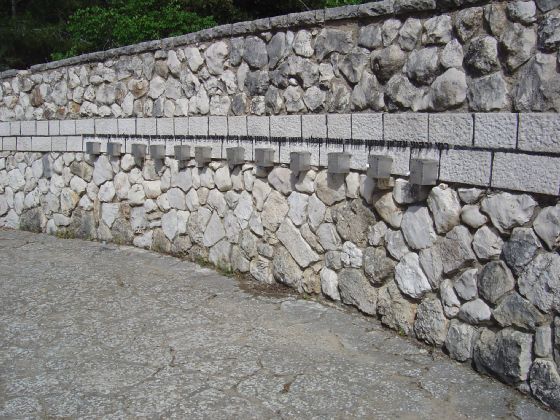

Memorial of the school bus massacre of 22 May 1970. Credit: www.ezy.co.il
In order to stop this terrorist activity, it was decided to build a fence system, including the installation of barriers, mines and jamming facilities. Moreover, routine patrols and observation posts were set up, ambushes were strained, some of them beyond the frontier. In May 1970, an armored attack was carried out in villages in the Fatah Land region, during which Israeli forces operated in enemy territory for two days. Israeli forces seized "Har Dov" and a military post was established at the top of the mountain to dominate the area. Subsequently, roads were opened to the "Fatah Land" region, allowing for more effective action against terrorists.
The terrorist organizations also operated outside of Israel - mainly against airlines linked in one way or another to Israel, and against Israeli embassies. The most notable event was the explosion of a "Swissair" airplane traveling from Zürich to Tel Aviv nine minutes after take-off. The attack, committed by the PFLP, cost the lives of all 47 occupants, including 13 Israelis, and the plane crashed into a forest near Würenlingen.
4. Post- War August 1970 - the Yom Kippur War
Intensification of clashes in the north of the country
During this period, security operations were concentrated in the Lebanese region. As a result of the civil war in Jordan, thousands of terrorists were expelled from Jordan. They concentrated in Lebanon and based themselves on the western slopes of Mount Hermon, in villages near the border with Israel, in refugee camps on the coast, and in Beirut. Their terrorist activities included incursions into Israeli territory, attempts to intrude by sea, to shoot at patrol vehicles along the northern border, and rocket attacks.
In January 1972, the number of attacks on the Lebanese border increased. Israel warned that if the attacks were to continue, the IDF would enter Southern Lebanon, and a temporary truce was therefore obtained. In February 1972, the IDF began to modify the way it operated, carrying out relatively deep raids and with numerous forces, including targeted Air Force operations that included bombing the heart of enemy territory. That same month, construction of a road leading to the Fatah Land area was completed, and an armored tank raid was carried out on the Ainata village. These raids forced the terrorists to leave these villages and set up their bases in the wilderness, with a corresponding decrease in the number of terrorist attacks. In September 1972, due to an escalation of violence at the Syrian border and an increase in terror attacks, including the Munich Massacre, the IDF launched an extensive offensive operation in Lebanon known as the "mini-offensive." In this operation, infantry and armored forces searched for terrorist outposts in southern Lebanon. Raids were carried out on the terrorist bases inside Lebanese territory - one on February 1973 on the bases near Tripoli and the second on April 1973 on the houses of terrorists leaders and their installations in Beirut.
In the Golan Heights region, most of the actions against Israel were carried out by terrorist organizations. These actions involved firing at the border, incursions into Israeli territory, and laying mines. The Syrian Army authorized these terrorist operations, and even took part in the incidents of shooting. As part of the deployment in the Golan Heights, the construction of military posts was completed and sections were added to the fencing system. In September 1972, the number of incidents reached a peak, and the IDF initiated an operation as part of the mini-offensive. This resulted in artillery fire, tank shelling, and aerial attacks on the terrorist bases and Syrian Army military posts. Some of these attacks were carried out deep into Syrian territory, as far north as Damascus. From October 1972 to January 1973, four days of fighting took place, and the soldiers were ordered to open fire against the Syrian line. As a result, relative peace was restored in the Golan Heights region.
Difficult maintenance of relative calm in southern Israel
In the Suez Canal area, after the ceasefire with Egypt in August 1970, the IDF began to improve its line of forts and establish a second line of bastions. New roads were laid, and the Israeli army prepared for the possibility of a resumption of fighting.

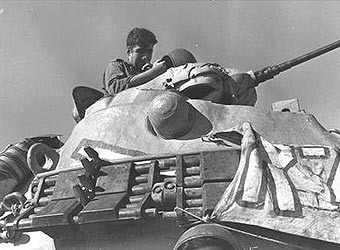
Israeli tank in the area of the Suez Canal during the War of Attrition
In the Gaza Strip, intense security operations began in 1971, after a period marked by numerous attacks. The most striking terrorist attack was the murder of Mark and Abigail Aroyo, two children who had gone on a family trip with their parents. The Southern Region Command concentrated most of its efforts on this area. The forces in the Gaza Strip were increased in number and remained in the area for longer periods.
The forces were present at all hours. Security operations were carried out by small units operating in a well-defined territory known to them, including routine search and ambush operations, while not neglecting special targeted operations. Israeli forces were also positioned in refugee camps to limit terrorist activity and roads to these camps were built to enable easier access. The maritime boundary was closed by the Israeli Navy. These operations reversed the situation: most terrorist cells were eradicated, terrorist leaders were killed, captured, surrendered or had fled. The calm was restored in the Gaza Strip.
Strong rise of attacks outside Israel
During this period, Palestinian terrorists increased the number of attacks outside Israel, including against non-Israeli and non-Jewish targets, with the aim of raising awareness of the Palestinian problem throughout the world. Various methods were used: hijacking of airplanes, attacks at airports, sending booby-trapped letters into Israel, killing civilians - all with the involvement of foreign terrorists in the ranks of these organizations. The most notable attacks were the hijacking of the Flight 571 of the Belgian airline Sabena traveling from Vienna to Tel Aviv on May 8 1972 by four terrorists from the "Black September" terrorist organization; the massacre at the Lod airport on May 30 1972, in which 26 people were killed and 80 wounded by three members of the Japanese Red Army who acted on behalf of the PFLP; and the massacre of 11 Israeli athletes at the Munich Olympics in early September 1972 by the "Black September" organization. Israel made every effort to outsmart attacks abroad by strengthening the protection of facilities, people, and aircraft and by attacking the terrorist bases where the attacks were being carried out.
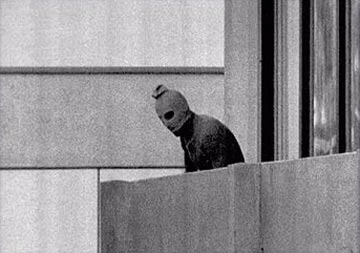

5. Exchange of Prisoners
During the War of Attrition, 12 IDF soldiers were captured by Egyptian forces and three by the Syrian forces. On August 16, 1970, an injured pilot was surrendered by Egypt and on March 29, 1971 another soldier returned from Egypt. On June 9, 1972, an exchange of prisoners took place with Syria, during which the three pilots that were captured in Syria were returned to Israel in exchange for five Syrian officers who had been captured by the IDF. On June 3, 1973, three Israeli pilots were returned to Israel after three years of captivity in Syria. In exchange for these three pilots, Israel released 46 Syrian prisoners.

